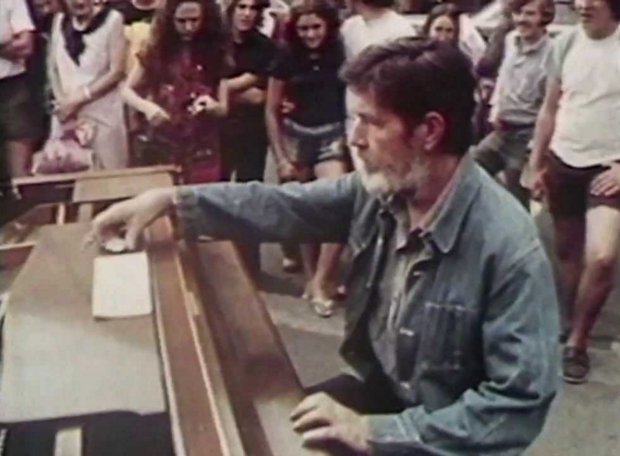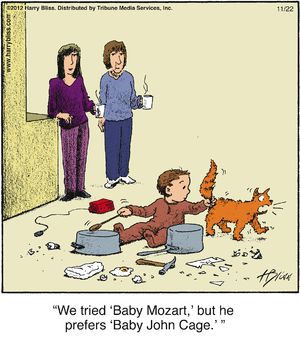Note: For our first real blog post, I thought I’d post an essay about John Cage that I wrote (to date myself) about 30 years ago, originally for the program guide of WCBN-FM Ann Arbor, the student radio station where I was a DJ and production director. The essay also was resident on WCBN’s website til about 1998. Historical reference: Cage died the year before this was written. It was also approximately one year after I bought my first digital sampler…
"Many people collect music that they like and surround themselves with it. I do the reverse: I don't keep music around me; I keep noise." -John Cage
“I believe that the use of noise to make music will continue and increase until we reach a music produced through the aid of electrical instruments which will make available for musical purposes any and all sounds that can be heard. Photoelectric, film and mechanical mediums for the synthetic production of music will be explored. Whereas, in the past, the point of disagreement has been between dissonance and consonance, it will be, in the immediate future, between noise and so-called musical sounds. The present methods of writing music principally those which employ harmony and its reference to particular steps in the field of sound, will be inadequate for the composer, who will be faced with the entire field of sound. New methods will be discovered, bearing definite relation to Shoenberg’s twelve-tone system. and present methods of writing percussion music, and any other methods which are free from the concept of a fundamental tone. The principle of form will be our only constant connection with the past. Although the great form of the future will not be as it was in the past, at one time the fugue and at another the sonata, it will be related to these as they are to each other: through the principle of organization or man’s common ability to think.”
-John Cage, The Future of Music: Credo (1937)
"Instantaneous and unpredictable, nothing is
accomplished by writing a piece of music.
Nothing is accomplished by hearing a piece of music.
Nothing is accomplished by playing a piece of music.
Our ears are now in excellent condition."
-John Cage, written in response to a
request for a manifesto on music, 1952

John Cage, one of this century’s greatest musical innovators and influences, lived to see his incredible early predictions about music come true. He passed away last summer, but his legacy will resound far into the next century, Cage addressed three important issues in experimental music today: the use of noise as music, nonnotated (improvised) music, and aleatoric (chance) music.
Using noise or “non-musical” sounds to make music has been greatly facilitated by modern technology. The development of the synthesizer and sampler have made it possible to utilize sounds that would either be very difficult to control in a performance or would simply not exist otherwise. Synthesizers, the first of these inventions, electronically create sounds from their fundamental waveforms. The most fascinating and innovative use of the sampler is not snatching a two measure groove from an old 70s disco tune, looping it, and using that as the rhythm track for some “new” dance hit. The sampler can be a much more sophisticated means of controlling and manipulating any sound. Anything you can hear and pick up with a microphone can be sampled, and then processed: spliced cut, reversed, sped up, slowed down, and filtered. Imagine composing and performing a quintet for chainsaw, chirping cricket, motorcycle, backwards atom bomb and waterfall.
On the other hand, this kind of sound art may be the farthest thing from Cage’s school of thought. He was in
many ways completely against controlling sound. By removing the ego from the compositional process, Cage
developed a whole new genre of aleatoric, or indeterminate, music. He used the I Ching (a Chinese divination
text), star maps, and amplification of ambient sounds as ways to generate music independently of decisions
made by the composer. The epitome of this occurred with his piece 4 minutes 33 seconds in which the performer
simply sits on stage and plays nothing. The main point of this (and there is a point) is to show that there is music
going on around us all the time in the form of whatever chance noises occurÑwhether it is a truck driving by, the soft patter of raindrops, or sneezing. Perhaps someday there will be no “musical performances” or recordings. Instead people will learn to simply listen to their surroundings…Well, it does seem highly unlikely, for as long as humans have the id to create their own noises, music will be both performed and recorded. (But it’s interesting to think about, isn’t it?)
Cage often used a milder form of indeterminacy in his work: improvisation. Often Cage would write only very
vague descriptions of the music to be played, leaving the rest up to the musicians performing the piece.
Improvisation is itself a relative term which comprises one end of a spectrum with pre-planned composition on
the other. A Beethoven symphony, for example, would be an extremely determined and pre-planned composition,
although open to interpretation by the individual musicians and the conductor. The “least improvised” music of
all would be an electronic composition, programmed into a computer. This piece would sound precisely the
same every time it is played, for the computer makes no mistakes and adds no embellishments.

Exploring the spectrum of improvisation, we pass through rock n’ roll, the blues, and of course Jazz, where improvisation has always been a centerpiece. The “freer’ the jazz means more improvisation, which means fewer and fewer rules are preordained for the musicians. More decisions must be made by them at the moment of performance (examples of very free jazz include Ornette Coleman, Anthony Braxton, and Last Exit.) Teetering on the edge of free jazz are artists like John Zorn (who in many pieces uses a “prompter’ rapidly holding up signs such as “surf’, ‘hardcore’, “country-western” and “lounge” signal when his players are to switch to a different style and improvise within it. Guitar improv geniuses like Bill Frisell, Fred Frith, and Henry Kaiser encounter the extremes of unplanned noise productions like Borbetomagus, a two saxophone and one guitar group that is reputed to be one of the loudest live acts in existence (metalheads take note).
Improvisation is the time between conception of a musical idea and its consumption’ or reception by those listening (assuming the performance is live.) So a musician must be “in the now”, as close to no thoughts of future or past as possible. According to Eastern philosophy, being in the now is synonymous with disconnecting from the ego. Now we come full circle to Cage’s indeterminacy.
The most extreme form of improvisation then, is total attention to your surroundings. Or, in a musical sense, listening to everything with no thought to the self. (At this point, I could make a convenient plug for WCBN and fundraising, but I will resist).
Noise as music. Undetermined, unplanned, “uncomposed’ music. These are the twin legacies left by the late
great Cage, and the two most exciting concepts in new music today.